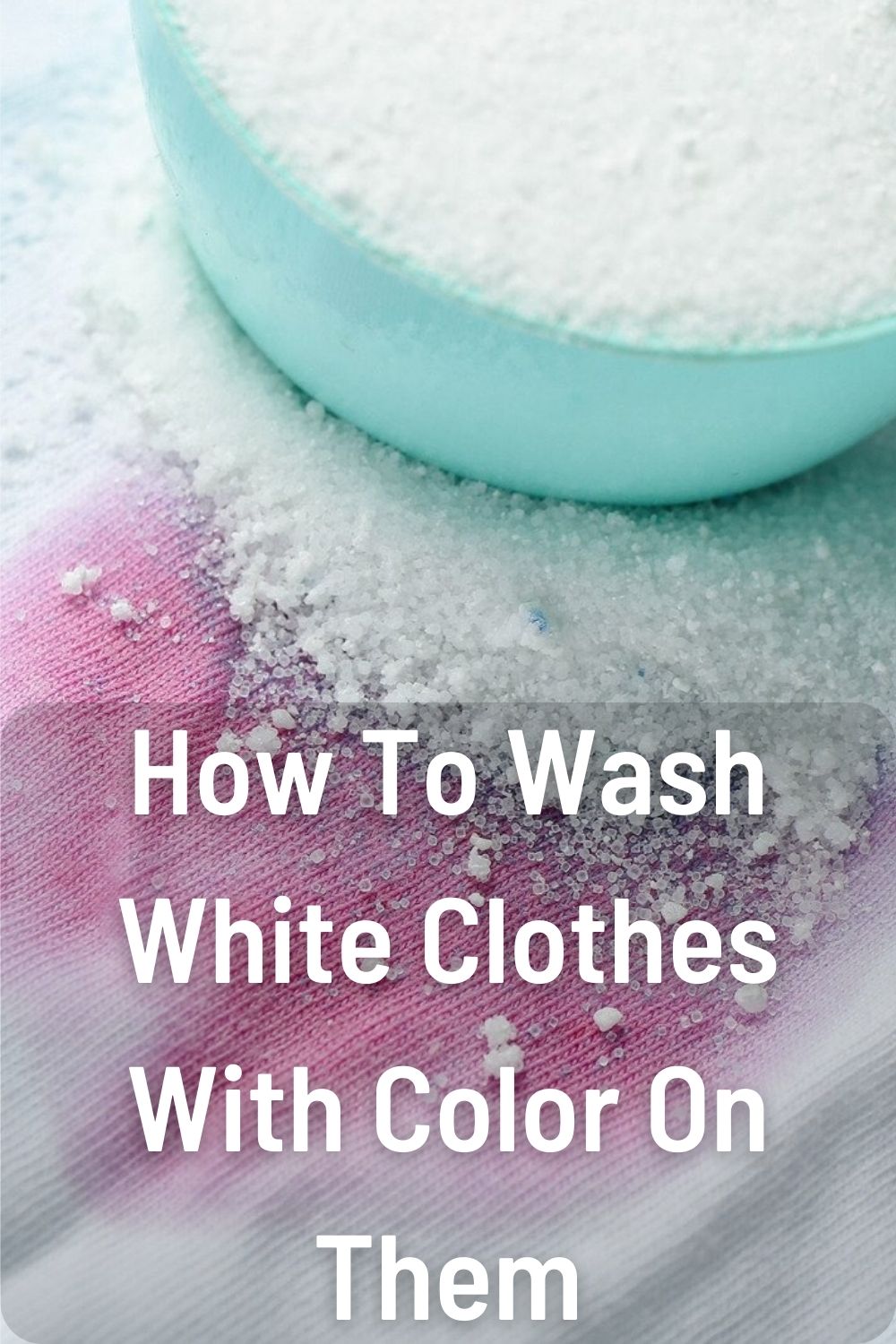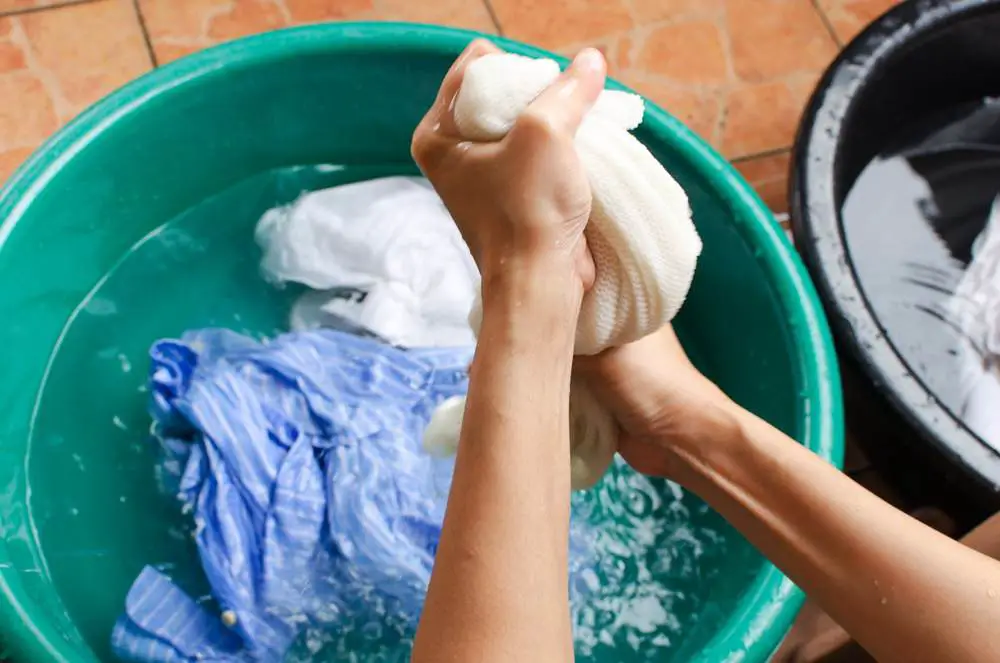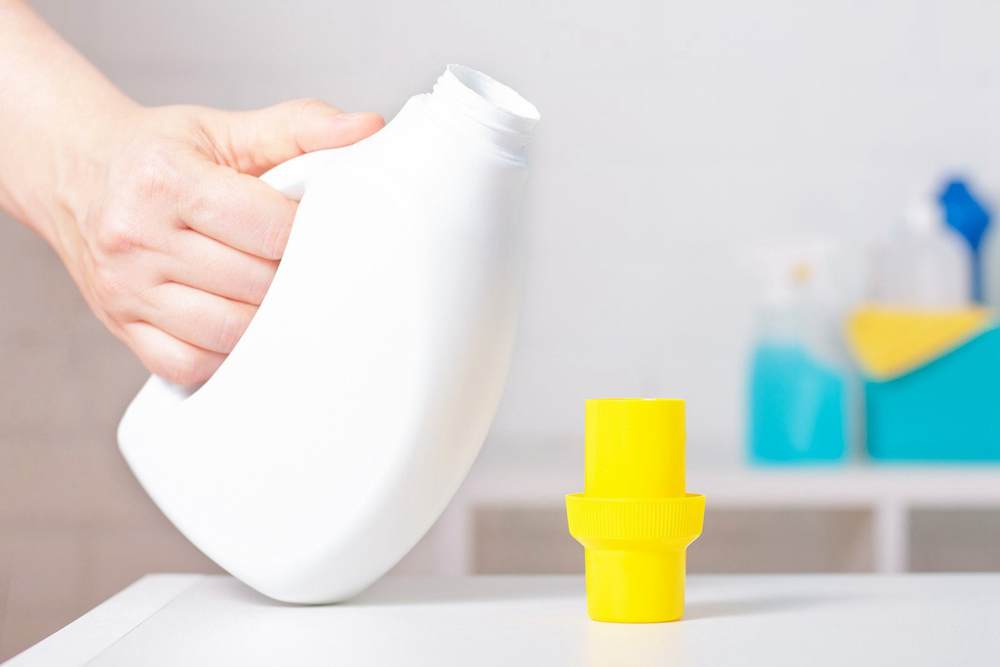
It can be frustrating when your white clothes get colored stains on them from other clothes in the wash. If you’ve ever had a pink sock turn a whole load of laundry pink, you know what I mean.
The good news is that there are some simple things you can do to wash white clothes that have color stains without ruining the rest of your laundry. In this complete guide, I’ll walk you through the best methods for washing white clothes with colors so you can keep your whites looking crisp and bright.
Table of Contents
Why Color Bleeds Onto White Clothes
Before we get into the solutions, let’s quickly go over why color bleeds onto white clothes in the first place during a wash cycle.
There are two main reasons:
Dye Transfer
Many colored fabrics contain excess dye, which can run when wet. If this excess dye comes into contact with white clothes, it can result in staining. The degree of staining depends on:
- The type and amount of dye used in the colored fabric. Dark colors like black, navy blue, and red contain a high concentration of dye.
- The age of the colored garment. Older clothes have more loose dye.
- The texture of the fabrics. Smooth fabrics like silk and satin absorb dye more readily than textured fabrics.
Insufficient Rinsing
When you wash colored and white garments together, the wash water becomes tinted with dye. If the clothes are not adequately rinsed, dye residue remains in the water and can redeposit onto white clothes.
So those are the two ways color ends up bleeding onto your bright whites in the wash. Now let’s look at the best techniques for avoiding this problem.
Segregate Laundry Loads
The most foolproof way to keep whites free of color is to separate them into different loads. Wash darks, brights, and whites in three separate cycles.
This guarantees colors don’t bleed into the wash water that white clothes soak in. It does take more time and effort, but for stain-free results, it can’t be beaten.
Tips for Segregating Laundry:
- Sort clothes by color family. Group darks, bright colors, pastels, and whites into different piles.
- Wash new colored items separately. They are most likely to bleed excess dye.
- Don’t overload washers. Clothes need room to move and rinse clean.
- Shake out clothes before washing. This prevents loose dye particles from rubbing off.
- Use color catchers. These sheets adsorb loose dyes in the wash water.
If you don’t have time for multiple loads, the next best option is washing in cold water.
Wash in Cold Water

Warm and hot water opens up fabric fibers, allowing dye to escape and spread more easily. Washing in cold water keeps fabric pores tight, preventing dye from escaping from colored clothes onto your whites.
The only exception is blood stains – use cold water to pretreat blood, but wash in warm to dissolve the proteins.
While washing in cold water reduces the chance of colors bleeding, it doesn’t guarantee white clothes will stay stain-free. For best results, take the following precautions:
- Turn clothes inside out. This keeps excess dye on the interior fabric rather than rubbing off on other items.
- Use a cold water detergent. They are designed to activate in lower temperatures.
- Add salt to the wash cycle. The salt helps block dye transfer.
- Rinse with cold water. Avoid warm rinses that could reopen fabric pores.
- Air dry if possible. The heat of machine drying can loosen dye.
Washing on a cold cycle takes longer, but it’s gentler on clothes and energy efficient. For whites that are only lightly soiled, it can be an easy way to avoid color bleed issues.
Use Color Catchers
Color catchers are designed to attract and trap dye released in the wash before it can redeposit onto fabrics. They are sheets you throw into the washing machine with your laundry.
Some popular brands are Shout Color Catchers, Carbona Color & Dirt Remover Sheets, and Woolite Color & Dirt Helpers.
Here’s how color catchers prevent dye transfer:
- They are covered in micro-capsules filled with an adhesive dye magnet.
- The capsules break open in the wash, releasing the adhesive.
- The adhesive attracts and binds to loose dye molecules suspended in the water before they can reattach to clothing.
- The sheet becomes colored with the absorbed dyes so they don’t bleed into other laundry items.
To use color catchers effectively:
- Use 1-2 sheets per load of laundry.
- Place them throughout the load, not just on top.
- Wash in cold or warm water, not hot water.
The adhesive can stain fabrics if directly contacted, so take the sheets out promptly when the cycle finishes.
Color catchers are a convenient way to keep white clothes white when washing with colors, but they aren’t 100% preventative. Separating loads is still the most reliable method.
Bleach White Clothes

Bleach can help remove dye that has already transferred onto white clothes, restoring their brightness. There are two main types of bleach:
Chlorine Bleach
Chlorine bleach (like Clorox) is the strongest and most effective type of bleach at whitening clothes. It oxidizes dye molecules, removing color in the process.
To bleach white clothes:
- Check garment care labels – chlorine bleach can damage some fabrics. Cotton, linen, and white synthetic fibers are generally safe.
- Pre-treat stains by applying diluted bleach directly to them. Let sit 5-10 minutes before washing.
- Add 1/2 cup bleach to the wash cycle with detergent. Use hot water for maximum effect.
- For heavy stains, soak clothes in a bleach solution before washing. Use 1/4 cup bleach per 1 gallon of water.
- Rinse clothes thoroughly – bleach can cause fabric damage if residue remains.
- Never mix chlorine bleach with ammonia-based cleaners! It creates a toxic gas.
While great at removing color, chlorine bleach can weaken and deteriorate fabrics over time. Don’t use it for every wash.
Oxygen Bleach
Oxygen bleach (like OxiClean) is gentler than chlorine bleach. It uses sodium percarbonate to lift stains and dirt.
Benefits of oxygen bleach:
- Safe for most colorfast fabrics
- Won’t yellow or degrade clothes like chlorine bleach
- Can soak clothes for hours, even overnight
The biggest downside is that it’s not as strong of a whitener as chlorine bleach. But it’s a good maintenance option if chlorine bleach would damage the fabric.
Soak in Vinegar or Citrus
For whites with mild dye stains, vinegar and lemon juice can help lift color without using harsh bleach. Thanks to the acidic compounds, they work to dissolve the dye bonds.
Vinegar soak:
- Mix 1 part white vinegar to 4 parts cold water.
- Soak clothes 1-2 hours.
- Wash as normal. The vinegar smell dissipates.
Lemon juice soak:
- Squeeze fresh lemon juice into cold water. Use about 1 lemon per gallon of water.
- Soak garments 1-2 hours.
- Wash as normal.
This organic method is inexpensive and fabric safe. But it may take a few repeats for more stubborn stains. You can also use citric acid powder for a stronger effect.
Dry in Sunlight
The UV rays of direct sunlight have natural bleaching and disinfecting abilities.
To dry white laundry in the sun:
- Hang clothes outside in direct sunlight.
- The sun’s UV rays help lift stains and brighten fabric.
- Don’t leave colored clothing out, as sunlight can fade dyes.
- Check garments a few hours later for dryness and remove promptly.
When possible, sunlight is an easy and eco-friendly way to naturally whiten clothes. Just be sure to remove laundry before it over-dries.
Remove Color Stains During Wash Cycle
If you notice a colored stain on a white garment in the midst of a wash cycle, don’t panic. You may be able to remove it mid-wash.
Here are some stain-removal tricks with supplies you likely have on hand:
- Bar soap: Rub a bar of soap onto the stain to absorb disperse dye. Rinse soap out before drying.
- Hydrogen peroxide: Mix peroxide with equal parts water and spray it directly on the stain. Adds bleaching action.
- Baking soda: Make a paste with water and scrub onto the stain. Helps lift color.
- White vinegar: Wet stain and pour vinegar straight onto it. Helps neutralize dye.
- Lemon juice: Squeeze fresh lemon juice onto the stain. The acidity helps remove dye.
- Borax: Make a borax paste with water and scrub onto stain. Helps lift color from fabric.
By pretreating stains as soon as they happen, you can often save the garment! Just be careful not to get chemicals on other laundry.
Now let’s go over some other laundry tips and tricks for preventing color transfer…
7 Tips To Prevent Color Bleeding In Laundry
Besides washing whites separately or in cold water, there are a few other things you can do to prevent colored clothes from staining your bright whites:
1. Zip zippers, button buttons, and tie strings before washing.
This keeps excess dye contained on the inside fabric rather than rubbing onto other clothes.
2. Wash new colored garments before mixing them with other laundry.
New clothing has the most excess dye that could bleed.
3. Use a dye magnet like Carbona Color Grabber when washing dark colors with whites.
These sheets attract loose dyes in the wash water before they stain fabrics.
4. Add white distilled vinegar to the rinse cycle.
The vinegar helps prevent dye transfer by tightening fabric fibers so dye can’t escape. Use 1/2 cup per load.
5. Wash clothing inside-out to prevent dye rubbing off from the outer fabric.
6. Check that your detergent doesn’t contain optical brighteners.
These can actually loosen dyes, causing more bleed issues.
7. Inspect whites carefully for stains before drying.
Heat can set stains. Pretreat stains before drying to avoid permanent setting.
Being proactive with these laundry habits will go a long way in keeping vivid colors from bleeding into your bright white clothes!
Common Questions About Washing Whites With Colors
To wrap up this guide, let’s go over some frequently asked questions about preventing color transfer onto white clothes:
1. Can you wash white clothes with color in cold water?
Yes, you can wash whites with colors in cold water. The cold temperature helps minimize dye bleeding. Just be sure to take extra precautions like washing inside-out and using color catchers for added protection.
2. Does vinegar keep colors from running in the wash?
Adding distilled white vinegar to the wash or rinse cycle helps prevent colors from running and staining other items. The vinegar acts as a dye mordant, sealing and setting the dye within the fibers. Use about 1/2 cup per load.
3. How do you get dye out of white clothes that have already been dried?
If the color stain has already set by drying, try soaking the garment in a solution of oxygen bleach and cool water for up to 8 hours before washing. Chlorine bleach is also an option if the fabric is bleach-safe. You may need to repeat these soaking treatments multiple times for stubborn stains.
4. Can you mix bleach and vinegar when washing white clothes?
It’s not recommended. Combining bleach and vinegar can create chlorine gas, which is highly toxic and dangerous to inhale or come in contact with. Use them in separate cycles instead.
5. What laundry detergent is best to prevent colors bleeding onto white clothes?
Look for a detergent specially formulated for cold water washing. These are designed to activate cleaning agents effectively in colder temperatures to get clothes clean while avoiding dye transfer issues. Tide Coldwater Clean and Persil ProClean are good options.
The Takeaway
Hopefully you now feel equipped to tackle color-stained whites with success. The keys are being proactive about stain prevention by:
- Always washing whites separately
- Using color catchers in mixed loads
- Washing in cold water
- Pretreating stains promptly
With a few precautionary measures, you can keep your bright whites vivid and prevent a pink sock situation. Just be diligent about laundry habits, and your whites will stay whiter longer.
Google İşletmem Yorum Satın Al
Monday 14th of August 2023
Thnx for share.. Very best post. Ty.